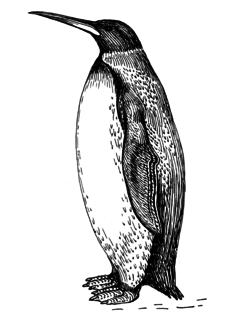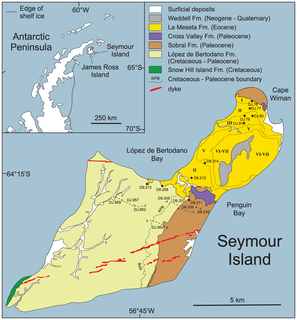
Penguins are a group of aquatic flightless birds. They live almost exclusively in the Southern Hemisphere: only one species, the Galápagos penguin, is found north of the Equator. Highly adapted for life in the water, penguins have countershaded dark and white plumage and flippers for swimming. Most penguins feed on krill, fish, squid and other forms of sea life which they catch with their bills and swallow it whole while swimming. A penguin has a spiny tongue and powerful jaws to grip slippery prey.

Traditionally, the bird order Apodiformes contained three living families: the swifts (Apodidae), the treeswifts (Hemiprocnidae), and the hummingbirds (Trochilidae). In the Sibley-Ahlquist taxonomy, this order is raised to a superorder Apodimorphae in which hummingbirds are separated as a new order, Trochiliformes. With nearly 450 species identified to date, they are the most diverse order of birds after the passerines.
Anthropornis is a genus of giant penguin that lived 45-33 million years ago, during the Late Eocene and the earliest part of the Oligocene. It reached 1.8 m in length from the tip of the beak to the tip of the tail, and 90 kg (200 lb) in weight. Fossils of it have been found in the La Meseta Formation on Seymour Island off the coast of Antarctica and in New Zealand. By comparison, the largest modern penguin species, the emperor penguin, is just 1.2 m long.

Presbyornis is an extinct genus of anseriform bird. It contains two unequivocally accepted species; the well-known P. pervetus and the much lesser-known P. isoni. P. pervetus was approximately the size and shape of a goose, but with longer legs; P. isoni, known from a few bones, was much larger, more than swan-sized. Other fossils, more doubtfully assigned to this genus, are also known.

Palaeeudyptes is an extinct genus of large penguins, currently containing four accepted species. They were probably larger than almost all living penguins, with the smaller species being about the size of an emperor penguin, and the largest species, Palaeeudyptes klekowskii, having stood up to 2 meters (6.6 ft) tall and weighed up to 116 kg (256 lb).

Palaeospheniscus is an extinct genus of penguins belonging to the subfamily Palaeospheniscinae. These penguins are apparently not closely related to the modern genus Spheniscus.
Palaeeudyptinae, the giant penguins, is a paraphyletic subfamily of prehistoric penguins. It includes several genera of medium-sized to very large species, such as Icadyptes salasi, Palaeeudyptes marplesi, Anthropornis nordenskjoeldi, and Pachydyptes ponderosus. Icadyptes reached 1.5 m in height, while members of Palaeeudyptes and Anthropornis grew even taller and were some of the largest penguins to have ever existed. The massive P. ponderosus may have weighed at least as much as an adult human.
Archaeospheniscus wimani is an extinct species of penguin. It was the smallest species of the genus Archaeospheniscus, being approximately 75 to 85 centimetres high, or about the size of a gentoo penguin. It is also the oldest known species of its genus, as its remains were found in Middle or Late Eocene strata of the La Meseta Formation on Seymour Island, Antarctica. It is known from a fair number of bones.
Archaeospheniscus lowei is the type species of the extinct penguin genus Archaeospheniscus. It stood approximately 85–115 cm high, between a modern king penguin and an emperor penguin in size. It is known from bones of a single individual and possibly some additional material such as the OM C.47.27 femur, all recovered from the Late Oligocene Kokoamu Greensand Formation at Duntroon, New Zealand.
Archaeospheniscus lopdelli was the largest species of the extinct penguin genus Archaeospheniscus, standing about 90–120 cm (35–47 in) high, or somewhat less than the extant emperor penguin. It is only known from bones of a single individual which was found in the Late Oligocene Kokoamu Greensand Formation at Duntroon, New Zealand. Bones apparently belonging to this species are now also known from the Late Eocene La Meseta Formation on Seymour Island, Antarctica.

Palaeeudyptes antarcticus, also referred to as the narrow-flippered penguin, is the type species of the extinct penguin genus Palaeeudyptes. It was a huge species, albeit probably with a large size variation. Although the size range can only be loosely estimated, the birds seem to have stood between 43 and 55 inches high in life, placing this species and its congener Palaeeudyptes marplesi among the largest penguin species known. It was the last known Palaeeudyptes species, and although the exact time when it lived is not precisely determined, it may have evolved from P. marplesi, or they might even have been a single species which slightly decreased in size over time.
Marples' penguin was a large species of the extinct penguin genus Palaeeudyptes.
Palaeeudyptes gunnari is an extinct species of the extinct penguin genus Palaeeudyptes. It was a bit smaller than its congener Palaeeudyptes antarcticus of New Zealand, standing between 110 and 125 cm high, approximately the size of the emperor penguin. It is known from dozens of fossil bones from Middle or Late Eocene strata of the La Meseta Formation on Seymour Island, Antarctica. Initially, it was described as a separate genus, Eosphaeniscus. However, this was based on a single weathered and broken tarsometatarsus. Better material recovered later showed that the species belongs into the present genus.

Palaeeudyptes klekowskii, also known as the colossus penguin, was a species of the extinct penguin genus Palaeeudyptes. It was until recently thought to have been approximately the size of its congener Palaeeudyptes antarcticus, which would mean it was somewhat larger than the modern emperor penguin, but a new study shows it was in fact almost twice as tall. Its maximum height is estimated to be up to 2 meters (6.6 ft) and maximum body mass up to 116 kg (256 lb). Knowledge of it comes from an extensive collection of fossil bones from the Late Eocene of the La Meseta Formation on Seymour Island, Antarctica. P. klekowskii was at first not recognized as a distinct species, and despite the coexistence of two so closely related species of similar size as Palaeeudyptes gunnari and P. klekowskii seeming somewhat improbable, the amount of fossil material suggests that the two species are indeed diagnosably different.
The extinct penguin Palaeospheniscus wimani is a member of the genus Palaeospheniscus, which belonged to the prehistoric subfamily Palaeospheniscinae. It was the largest member of its genus, being just as large as the Magellanic penguin of today.

The Pelagornithidae, commonly called pelagornithids, pseudodontorns, bony-toothed birds, false-toothed birds or pseudotooth birds, are a prehistoric family of large seabirds. Their fossil remains have been found all over the world in rocks dating between the Early Paleocene and the Pliocene-Pleistocene boundary.

Seymour Island or Marambio Island, is an island in the chain of 16 major islands around the tip of the Graham Land on the Antarctic Peninsula. Graham Land is the closest part of Antarctica to South America. It lies within the section of the island chain that resides off the west side of the peninsula's northernmost tip. Within that section, it is separated from Snow Hill Island by Picnic Passage, and sits just east of the larger key, James Ross Island, and its smaller, neighboring island, Vega Island.

Dasornis is a genus of the prehistoric pseudotooth birds. These were probably rather close relatives of either pelicans and storks, or of waterfowl, and are here placed in the order Odontopterygiformes to account for this uncertainty.

The La Meseta Formation is a sedimentary sequence deposited during the Eocene. The formation is found on Seymour Island, Antarctica.

Llanocetus is a genus of extinct toothed baleen whales from the Late Eocene of Antarctica. The type species, Llanocetus denticrinatus, reached gigantic proportions, with the juvenile specimen reaching an estimated 8 m (26 ft) in length; a second, unnamed species, known only from three isolated premolar teeth, reached an estimated total body length of up to 12 m (39 ft). Like other contemporary baleen whales of the Eocene, Llanocetus completely lacked baleen in its jaws. It was probably a suction feeder like the modern beaked and pygmy right whales.











